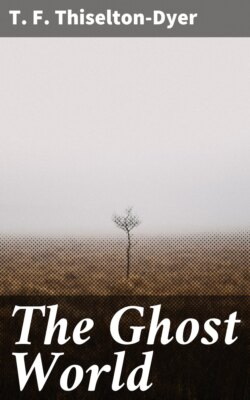The Ghost World

Реклама. ООО «ЛитРес», ИНН: 7719571260.
Оглавление
T. F. Thiselton-Dyer. The Ghost World
The Ghost World
Table of Contents
CHAPTER I. THE SOUL’S EXIT
CHAPTER II. TEMPORARY EXIT OF SOUL
CHAPTER III. THE NATURE OF THE SOUL
CHAPTER IV. THE UNBURIED DEAD
CHAPTER V. WHY GHOSTS WANDER
CHAPTER VI. GHOSTS OF THE MURDERED
CHAPTER VII. PHANTOM BIRDS
CHAPTER VIII. ANIMAL GHOSTS
CHAPTER IX. PHANTOM LIGHTS
CHAPTER X. THE HEADLESS GHOST
CHAPTER XI. PHANTOM BUTTERFLIES
CHAPTER XII. RAISING GHOSTS
CHAPTER XIII. GHOST LAYING
CHAPTER XIV. GHOSTS OF THE DROWNED
CHAPTER XV. GHOST SEERS
CHAPTER XVI. GHOSTLY DEATH-WARNINGS
CHAPTER XVII ‘SECOND SIGHT’
CHAPTER XVIII. COMPACTS BETWEEN THE LIVING AND DEAD
CHAPTER XIX. MINERS’ GHOSTS
CHAPTER XX. THE BANSHEE
CHAPTER XXI. SEA PHANTOMS
CHAPTER XXII. PHANTOM DRESS
CHAPTER XXIII. HAUNTED HOUSES
CHAPTER XXIV. HAUNTED LOCALITIES
CHAPTER XXV. CHECKS AND SPELLS AGAINST GHOSTS
CHAPTER XXVI. WRAITH-SEEING
CHAPTER XXVII. GHOSTLY TIMES AND SEASONS
CHAPTER XXVIII. SPIRIT-HAUNTED TREES
CHAPTER XXIX. GHOSTS AND HIDDEN TREASURES
CHAPTER XXX. PHANTOM MUSIC
CHAPTER XXXI. PHANTOM SOUNDS
INDEX
FOOTNOTES
Отрывок из книги
T. F. Thiselton-Dyer
Published by Good Press, 2019
.....
And I shall know him when we meet.
Despite the fact that the disembodied spirit has been supposed to retain its familiar likeness, we find all kinds of strange ideas existing in most parts of the world as to what sort of a thing it really is when its condition of existence is so completely changed. Thus, according to a conception which has received in most ages very extensive credence, the soul has substantiality. This was the Greek idea of ghosts, and ‘it is only,’ writes Bishop Thirwall, ‘after their strength has been repaired by the blood of a slaughtered victim, that they recover reason and memory for a time, can recognise their living friends, and feel anxiety for those they have left on earth.’ A similar notion of substantiality prevailed among the Hebrews, and, as Herbert Spencer points out, ‘the stories about ghosts accepted among ourselves in past times involved the same thought. The ability to open doors, to clank chains, and make other noises implies considerable coherence of the ghost’s substance.’[31] That this conception of the soul was not only received but taught, may be gathered from Tertullian, who says: ‘The soul is material, composed of a substance different to the body, and particular. It has all the qualities of matter, but it is immortal. It has a figure like the body. It is born at the same time as the flesh, and receives an individuality of character which it never loses.’ He further describes[32] a vision or revelation of a certain Montanist prophetess, of the soul seen by her corporeally, thin and lucid, aerial in colour, and human in form. It is recorded, too, as an opinion of Epicurus, that ‘they who say the soul is incorporeal talk folly, for it could neither do nor suffer anything were it such.’ It was the idea of materiality that caused the superstitious folk in years gone by to attribute to ghosts all kinds of weird and eccentric acts which could not otherwise be explained. And yet it has always been a puzzle in Animistic philosophy, how a ghost could be possessed at one moment of a corporeal body, and immediately afterwards vanish into immateriality, escaping sight and touch. But this strange ghost phenomenon is clearly depicted in sacred history, where we find substantiality, now insubstantiality, and now something between the two, described. Thus, as Herbert Spencer remarks,[33] ‘the resuscitated Christ was described as having wounds that admitted of tactual examination, and yet as passing unimpeded through a closed door or through walls.’ And, as he adds, the supernatural beings of the Hebrews generally, ‘whether revived dead or not, were similarly conceived: here, angels dining with Abraham, or pulling Lot into the house, apparently possess complete corporeity; there, both angels and demons are spoken of as swarming invisibly in the surrounding air, thus being incorporeal; while elsewhere they are said to have wings, implying motion by mechanical action, and are represented as rubbing against, and wearing out, the dresses of Rabbis in the Synagogue.’ All kinds of strange theories have been suggested by perplexed metaphysicians to account for this duplex nature of the disembodied soul; Calmet having maintained that ‘immaterial souls have their own vaporous bodies, or occasionally have such vaporous bodies provided for them by supernatural means to enable them to appear as spectres, or that they possess the power of condensing the circumambient air into phantom-like bodies to invest themselves in.’[34]
.....